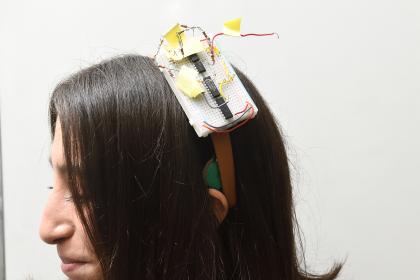A team of undergraduate engineers at Johns Hopkins University is working on a noninvasive, wearable, and reusable device that combats migraine headaches.
Electrical and computer engineering students Rita Rozental, Christian Kanzki, and Kyle Cooper call their device Cerebri. It works by stimulating and desensitizing the trigeminal nerve, located in the face and head and believed to play a key role in the origin of migraines. The students will display their prototype and describe their approach at the Whiting School of Engineering's annual Design Day on May 1.
Cerebri relies on dry electrodes, which do not require direct skin contact or the use of gels or pastes, to transmit low-level electrical pulses to the trigeminal nerves. Team members say that this innovative approach circumvents the drawbacks of wet electrodes, such as skin irritation and limited usability on hairy skin or areas prone to sweat.
Putting on the device is as easy as wearing a headband, although it should be be positioned on atop the head for optimal stimulation and discreetness during daily use. This band holds the dry electrodes against the scalp, delivering electrical impulses to the trigeminal nerve.

Image caption: Rita Rozental models Cerebri
Image credit: Will Kirk / Johns Hopkins University
"According to current research, the stimulation should be effective after 20 minutes to an hour of wear but the device could be worn for longer if needed, as it is used both to treat migraines at their onset and to prevent future migraines," said Rozental, whose team developed the appliance for its engineering senior design project.
The team believes Cerebri's uniqueness lies not only in its combination of existing technologies and possible patentability but also in the fact that it is wearable, cost-effective, and can easily be integrated into users' daily lives. As the twin sister of a migraine sufferer, Rozental knows how much such a device is needed.
"Pharmaceuticals [for migraines] come with long trial periods and no guarantee of relief," she says. "Current electrostimulation treatments, while promising, are expensive, can only be applied to hairless areas of the head, and are impractical for daily wear. We hope our device will give migraine sufferers another effective and affordable option."
For more Design Day stories, visit the Whiting School's newsroom.
Posted in Science+Technology
Tagged health care, electrical and computer engineering, design days, whiting school









